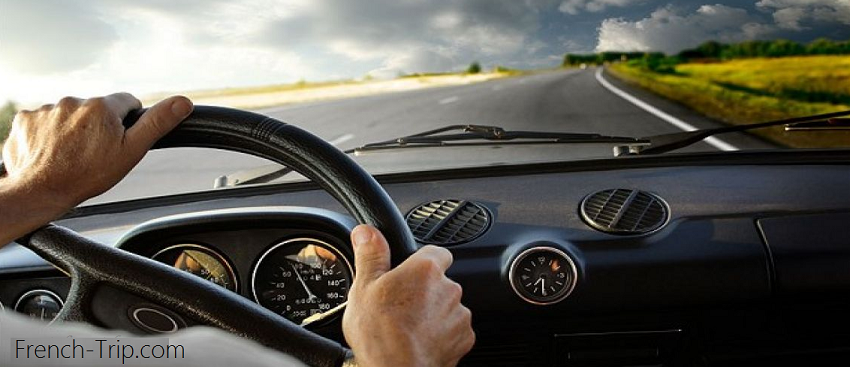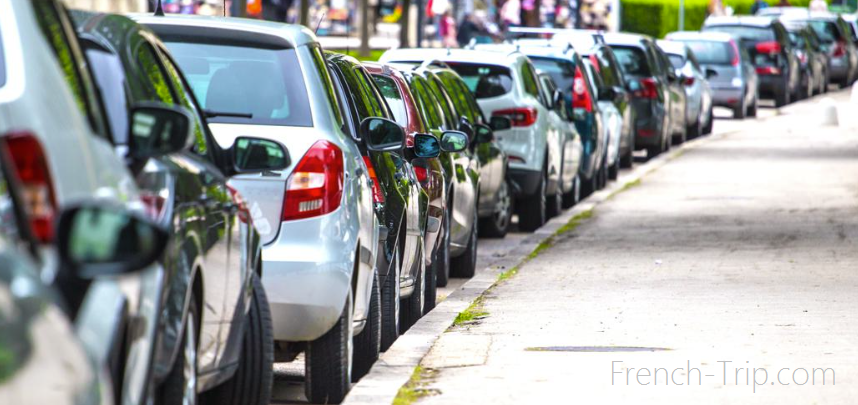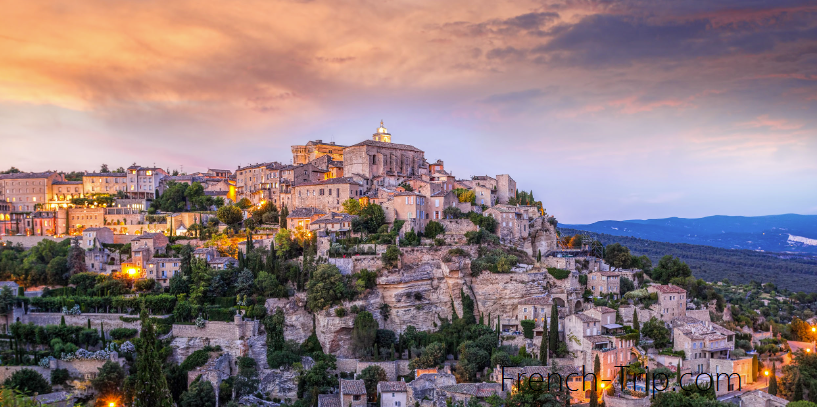France by car

Travelling in France by car – is often the easiest way to explore this beatiful country! Despite the network of high-speed TGV trains and generally good transportation, many of the most beautiful places in France are more conveniently reached by car. Whether it’s cheaper to travel by car than by train is another question. For long distances, trains are still better.
In some regions of France, public transportation is extremely poor. In Corsica, for example, a bus between even major cities may run once a day. Many villages from the Association of the Most Beautiful Villages in France are almost inaccessible by public transportation, not to mention the lavender fields of Provence, lost on mountainous plateaus.
So if you don’t plan to limit yourself to major cities, it’s better to rent a car (approximately from €35 per day) or bring your own. You just need to be aware of local traffic rules and potential expenses to properly plan your trip.
Useful to know for traveling by car in France:
- Toll roads: Most highways in France are toll roads.
- Traffic rules: Speed limits and other requirements.
- Fines: Amounts for various violations.
- Parking: Main parking rules in France.
- Saving money: How to travel as economically as possible in France.
- Which is cheaper: car, train, or bus? What to choose?

When WORTH to travel by car in France?
- If you plan to visit small villages: Alsace, Provence, Occitanie… In some villages, there is no transport at all (e.g., Beynac-et-Cazenac and similar). In others (e.g., Eguisheim), there are only a couple of buses a day (and no buses on Sundays). In many beautiful villages of Provence, there is a tourist bus only in the high season — July and August. Twice a day. In such cases, a car will be indispensable — you will see much more and won’t waste time waiting for rare buses.

- If you plan to visit natural attractions: the lavender fields of Provence (you can reach the centers by train and then go on foot (but in 30+ degree heat?) or by bike (but where to get one?), there are tourist excursions — but the price is entirely different), gorges (the panoramic route through the Verdon Gorge is a highlight of France, Gorges de Galamus — the road is crowded in summer), the famous Calanques of Marseille, where even from the road it’s a long walk, and Corsica, where transport is terrible, and the road through the mountains is a separate attraction (e.g., the calanques of Piana).

- If you have a very tight travel schedule: then there’s simply no time to wait for transport, which may not always be available and with gaps. For comparison: in Provence, it is possible to visit 4-5 villages in a day by car, while by bus — at best, in season — 2.
- When traveling 4-5 people togerther — since transport expenses are proportional to the number of people, and the toll and fuel costs remain constant, if there are many people, a car trip is likely cheaper. Probably, with three people, a car will still be more advantageous (though with children, the fare is 50%, so it depends on the group composition), with two people, discounted tickets for high-speed TGV trains for long distances will surely be cheaper (and much faster!), regular trains with fixed fares — definitely more expensive. Considering buses, fares can be as low as €1 — so the travel time might be almost the same, but the cost can be significantly lower, even for a group of several people.
When should you NOT travel by car?
- When the destination is a big city. Parking is expensive or simply unavailable, driving is complicated, the French love to park by ear judging by the scratched bumpers of all the cars in Paris. On May 1st, it’s better not to be in any Paris (or in suburban immigrant areas during New Year’s — as they have adopted the tradition of burning cars, you might get caught up with them!).
![]()
- When the purpose of the trip is wine tourism. This is tricky, of course: many of the best wine villages are not easily accessible without your own transport, but driving after drinking is not great either. You could practice self-control (thankfully, sipping a glass is allowed — 0.5 blood alcohol level is permissible, which is roughly equivalent to a bottle of beer or a glass of wine), or find a compromise and taste wines in more accessible places by train. In Champagne and Bordeaux, it’s popular to stay overnight at vineyards — you pay like for a hotel, in the evening you sit, dine with the host and other guests, talk about wines. In Champagne, we tried about 4 types of champagne at such a dinner. It’s delicious, interesting, educational, authentic, and you don’t have to drive anywhere. However, you had to get to such a place by car. An alternative is wine tastings at the Champagne houses in Épernay and Reims — and then you can calmly go to sleep, not get behind the wheel.

- When the trip coincides with a festival or holiday. Even in remote Alsatian villages during the Christmas market, there can be so many people that cars park half a kilometer away, on trails in the vineyards. And what about major festivals! In such cases, all hotels and hotel parking will be full.
- When traveling alone — trains and buses are almost certainly cheaper, especially if you book tickets in advance.

Is it convenient to travel by car in France?
We have traveled the country far and wide, both in our own and rental cars. Overall, traveling was quite comfortable everywhere and the signs were understandable. It’s most comfortable to drive in “village” areas, such as the Dordogne Valley, Brittany. The main problem is parking in big cities and traveling during the high season in some parts of the French Riviera, where endless traffic jams form. For example, the road to Saint-Tropez is an endless traffic jam that cannot be avoided.
On the plus side, there is a fairly high standard of roads. If in Italy you might encounter a toll road that has long needed repairs, in France all the toll roads we encountered were perfect. But don’t neglect them. Attempting to save money by traveling on free roads can turn into a nightmare of endless roundabouts and start-stops. In the end, it won’t be cheaper.
France is now actively transitioning to mobile parking payments — this is a big plus compared to their prehistoric payment system with cards or meters that only accepted coins. So, don’t be lazy and download the parking apps of the cities you plan to stay in.
Useful to know when traveling by car in France:
- Almost all highways in France are toll roads. Regional roads are usually free. Tunnels in the mountains (Alsace, French Alps) are toll roads. Payment is by cash or credit card.
- TOLL ROADS ARE WORTH IT! Although expensive, in the end, they will be cheaper.
- Free roads through populated areas mean endless roundabouts at every intersection. Not everywhere, but many places.
- There are regions where almost all roads are free. For example, Alsace. There, only the tunnel is a toll road, and all highways from Strasbourg to Mulhouse are free.
- Regional roads are usually free. So, you can travel around Brittany or Normandy for free. High-speed highways connecting key cities of the country (Paris — Lyon — Avignon — Perpignan) are all toll roads.
- In many cities, street parking is free on Sundays and holidays, as well as at lunchtime and in the evening after 19:00. Sometimes parking is only paid during the summer season (tourist villages).
- Fines are identified by the car’s number and can be sent to your country. Failure to pay the fine results in being placed on the debtor list and possibly banned from entering the EU/Schengen area.
- In large cities in France, there can be safety issues (Paris, Marseille), so it’s better not to leave anything valuable in the car. In tourist regions’ villages (Alsace, Dordogne, Brittany), everything is much calmer and safer.
- Gas at parking lots along highways is usually more expensive than in cities.
- Renting a car in France usually costs from €35 per day if booked in advance and for several days. For one day, you can easily find a car within €50. Renting at airports is usually cheaper.
Useful websites for planning car routes in France:
Archives
Calendar
| M | T | W | T | F | S | S |
|---|---|---|---|---|---|---|
| 1 | 2 | 3 | 4 | 5 | 6 | 7 |
| 8 | 9 | 10 | 11 | 12 | 13 | 14 |
| 15 | 16 | 17 | 18 | 19 | 20 | 21 |
| 22 | 23 | 24 | 25 | 26 | 27 | 28 |
| 29 | 30 | 31 | ||||